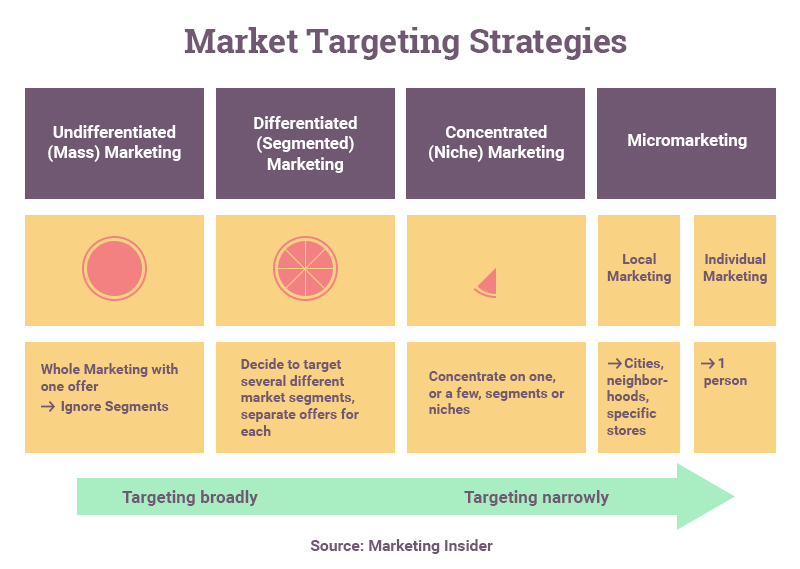
Why Using Differentiated Marketing Can Save Your Company
Last update: 27 October 2022 at 12:00 pm
There’s an essential step all businesses need to take before launching any marketing campaigns. That is to determine the brand’s target audience. Brands usually segment their audience into groups to communicate with them more efficiently.
There are three main target market strategies: differentiated marketing, undifferentiated marketing, and concentrated marketing. Each one of them has its advantages. But in this article, I’ll discuss why differentiated marketing is especially advantageous and how can it help a new business grow.
What is Differentiated Marketing Strategy
A differentiated marketing strategy is when a company creates marketing campaigns appealing to two or more different audience segments or demographics.
Differentiated marketing allows businesses to reach a wider audience by using separate marketing approaches for different target segments.
Simply put, it is a marketing strategy with more than one target market. A differentiated marketing strategy occurs when a company has a different approach in terms of product or service offering, price, and promotion for each target segment.

Differentiated marketing strategies can also involve companies using different messages to different target groups. For example, retail businesses might offer high product quality to a wealthy market segment and low cost to a budget-conscious segment.
Think of a restaurant. A restaurant might have different marketing approaches to customers in different age groups. The restaurant can send a short video describing the delicious food and high-quality ingredients to the young customers. An advertisement showing the restaurant‘s comfortable and family-oriented atmosphere can be sent to the seniors.
The Benefits of a Differentiated Marketing Strategy
Differentiated marketing strategies have several key benefits. A differentiated marketing strategy helps businesses deliver a more personalized message to their audiences, fulfill the needs of the customers, and increase revenue.
An experienced digital marketing agency can help your company get started on a marketing strategy catered to your needs and goals.
Delivering a Personalized Message
Each audience has different segments and each segment has different needs and expectations. Customers find it easier to connect with a company that creates unique approaches to each of these segments. Delivering a more personalized experience to the members of the audience is a great way of building a loyal customer base.
Reaching More Customers
A differentiated marketing strategy can expand customer reach significantly. Businesses that implement differentiated marketing can focus on two or more segments and fulfill a wide range of needs. Since it focuses on multiple segments, it allows brands to reach more customers.
Increasing Income
In a differentiated marketing strategy, businesses offer their products to multiple markets. As a result, businesses are able to increase their revenue. That’s the reason why many companies around the world aim to expand into new market segments. In order to do so, a company needs to diversify its offerings and differentiate its marketing approaches.
It Can Be a Competitive Advantage
Brands that offer a wide variety of products always stand out in the competition. Companies that can fulfill diverse needs can gain a competitive advantage compared to the companies that focus on one specific need.

Differentiated marketing can help small businesses reach their target audience and build brand awareness. But what are the benefits of undifferentiated and concentrated marketing? Keep reading to find out.
Undifferentiated Marketing
While differentiated marketing appeals to two or more well-defined market segments, undifferentiated marketing strategy means promoting a product to a wide audience without specific parameters. Moreover, an undifferentiated marketing strategy involves companies using the same message for all target groups.
In undifferentiated marketing strategies, marketing teams create a message that is appealing to everyone. The message is often short and simple, allowing more customers to relate to it. The main goal of undifferentiated marketing is to reach customers with one product, one price, and one campaign. Everyone gets the same message.

Reputation and brand image are key factors in undifferentiated marketing strategies. Brands focus on high quality or a certain set of features of their product. In an undifferentiated marketing strategy, brands gain a competitive advantage by providing high-quality products.
Undifferentiated marketing is also known as mass marketing. It doesn’t require research or a specific campaign for each market segment. Brands that implement undifferentiated marketing try to show that everyone needs their products in everyday life. That way brands are building brand awareness and getting a larger reach.
Concentrated Marketing
Concentrated marketing occurs when a company targets one specific market segment and directs all efforts to market a product for this segment or audience.
Much like differentiated marketing, a concentrated marketing strategy is especially beneficial to small businesses as it’s designed to appeal to one market segment.
One of the most important advantages of concentrated marketing strategies is the opportunity to fully understand the needs of a specific segment. A company can fulfill the needs efficiently, getting more loyal customers as a result. Another great benefit of a concentrated marketing strategy is its cost-effectiveness.
Smaller businesses that implement concentrated marketing strategies typically have one service or product offering at one price. With a concentrated marketing strategy, a business can efficiently meet the needs of a certain segment of customers.
Differences Between Undifferentiated, Concentrated, and Differentiated Marketing Strategies
It’s essential to understand the differences between the marketing strategies in order to choose the one that works best for your business. There are several aspects in which the three strategies differ.
Target Markets
The goal of differentiated marketing is to focus on two or more target markets. In concentrated marketing, businesses aim for one well-defined target market. In undifferentiated marketing, there’s no need for companies to define the target markets; the whole point is to aim for a wider audience and show that people need the brand’s products every day.

Product or Service Offerings
Product or service offerings are another key aspects in which the strategies differ. Differentiated marketing involves a company offering a wide variety of products or services. Different products are offered to different market segments in order to reach more customers.
Businesses that use undifferentiated or concentrated marketing strategies may have one product offering. However, it’s worth noting that there’s a difference between those two cases. In undifferentiated marketing, a product can appeal to almost every type of customer and reach a wide audience. In concentrated marketing, the product is appealing to a defined market.
Prices
Not only the products offerings but also the product prices differ between the marketing strategies.
As mentioned above, companies offer a wide range of products or services to several market segments in differentiated marketing. That’s why prices for products and services usually vary.
In contrast to differentiated marketing, concentrated marketing involves a single product offering at the same price range. With undifferentiated marketing, businesses will typically have the same price point for a limited amount of products.
Promotion
Under differentiated marketing, several promotional outlets are used. A brand that uses differentiated marketing should pay attention to the needs of every market group the brand targets.
Brands that use concentrated marketing may promote their product through the main advertising outlet that’s used by the brand’s target market.
In undifferentiated marketing, businesses prefer using promotional outlets such as media outlets that aren’t necessarily specific to any market segment.
Main Advantages of Differentiated Marketing
Based on the above discussions, we can notice that differentiated marketing is a great choice for a brand to achieve several essential goals.
Differentiated marketing allows a brand to communicate with every segment of its audience. When every customer is getting a personalized message, it’s more likely the customers will find your product or service relevant and useful.
A small business can successfully expand and increase its customer base thanks to differentiated marketing. A differentiated marketing strategy involves creating a variety of products for several market segments, meeting a wide range of customer needs as a result. It helps a business adapt and further explore the market.
Final Thoughts about Differentiated Marketing
Using a differentiated marketing strategy is an opportunity to stand out in the competition. Even though it’s especially beneficial for small businesses, it’s one of the best choices for any company to grow and build brand awareness.





